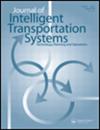Transit Signal Priority under Connected Vehicle Environment: Deep Reinforcement Learning Approach
IF 2.8
3区 工程技术
Q3 TRANSPORTATION
Journal of Intelligent Transportation Systems
Pub Date : 2025-09-03
DOI:10.1080/15472450.2024.2324385
引用次数: 0
Abstract
Transit Signal Priority (TSP) is a traffic signal control strategy that can provide priority to transit vehicles and thus improve transit service and enhance transportation equity. Conventional TSP strategies often ignore the fluctuation of passenger occupancy in transit vehicles, leading to sub-optimal solutions for the entire system. The use of Connected Vehicle (CV) technology enables the adoption of a more fine-grained objective in optimizing traffic signals, such as person delay, by allowing real-time information on passenger occupancy to be obtained. In this study, a deep reinforcement learning algorithm, deep Q-network (DQN), is applied to develop a traffic signal controller that minimizes the average person delay. The proposed DQN controller is tested in a simulation environment modeled after a real-world intersection and compared with pretimed and actuated controllers. Results show that the proposed DQN controller has the best performance in terms of average person delay. Compared to the baseline, it reduces the average person delay by 18.77% in peak hours and 23.37% in off-peak hours. Furthermore, it also results in decreased average delays for both buses and cars. The sensitivity analysis results indicate that the proposed controller has the potential for practical applications, as it can effectively handle some dynamic changes.
车联网环境下的公交信号优先:深度强化学习方法
公交信号优先(TSP)是一种交通信号控制策略,可为公交车辆提供优先权,从而改善公交服务并提高交通公平性。传统的 TSP...
本文章由计算机程序翻译,如有差异,请以英文原文为准。
求助全文
约1分钟内获得全文
求助全文
来源期刊
CiteScore
8.80
自引率
19.40%
发文量
51
审稿时长
15 months
期刊介绍:
The Journal of Intelligent Transportation Systems is devoted to scholarly research on the development, planning, management, operation and evaluation of intelligent transportation systems. Intelligent transportation systems are innovative solutions that address contemporary transportation problems. They are characterized by information, dynamic feedback and automation that allow people and goods to move efficiently. They encompass the full scope of information technologies used in transportation, including control, computation and communication, as well as the algorithms, databases, models and human interfaces. The emergence of these technologies as a new pathway for transportation is relatively new.
The Journal of Intelligent Transportation Systems is especially interested in research that leads to improved planning and operation of the transportation system through the application of new technologies. The journal is particularly interested in research that adds to the scientific understanding of the impacts that intelligent transportation systems can have on accessibility, congestion, pollution, safety, security, noise, and energy and resource consumption.
The journal is inter-disciplinary, and accepts work from fields of engineering, economics, planning, policy, business and management, as well as any other disciplines that contribute to the scientific understanding of intelligent transportation systems. The journal is also multi-modal, and accepts work on intelligent transportation for all forms of ground, air and water transportation. Example topics include the role of information systems in transportation, traffic flow and control, vehicle control, routing and scheduling, traveler response to dynamic information, planning for ITS innovations, evaluations of ITS field operational tests, ITS deployment experiences, automated highway systems, vehicle control systems, diffusion of ITS, and tools/software for analysis of ITS.

 求助内容:
求助内容: 应助结果提醒方式:
应助结果提醒方式:


